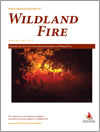International Journal of Wildland Fire
Volume 28
Number 6 2019
We evaluate whether arrests of intentional illegal firesetters lead to movements in or reductions of future fires in nearby locations. Our analyses of daily wildfire count data from Galicia, Spain, from 1999 to 2014, show that arrests lead to overall reductions in intentional illegal firesetting.
The arduous work, coupled with unpredictable environments, associated with wildland firefighting cultivates injury risk in wildland firefighters (WLFFs). Costs for treating WLFF injuries are on the rise, warranting a targeted approach to physical training and a job-specific injury prevention program focusing on the lower extremities.
Currently for forest fire risk, actuarial and underwriting pricing and risk management methods have stuck to methods based purely on historical loss data. Here, a fire spread model and a stochastic approach combined in Monte Carlo simulations is shown to improve evaluation of the spatial and temporal distribution of the uncertainties of hazard and losses.
We conducted an analysis of the relationship between annual fire activity and climate at two spatial scales in the Western Ghats mountain range in India. Results indicate that fuel aridity and drought stress metrics are important drivers of fire activity in some vegetation classes.
Accuracy of monthly drought codes increased after accounting for overwinter drying, early fire season starts, and effective precipitation. April–August drought codes were significantly associated with historical fires. Variations in fire-season drought influenced fire severity, connecting modern fire-weather indices with historical mixed-severity fire regimes in montane forests of south-eastern British Columbia.
We evaluated decomposition of standard wood substrates located on the soil surface, at the forest floor–mineral soil interface and in the mineral soil after high-severity wildfires and in an adjacent unburned control. Soil temperature and moisture changes associated with canopy loss from wildfires resulted in increased decomposition and microsite variability on two national forests in the western USA.




